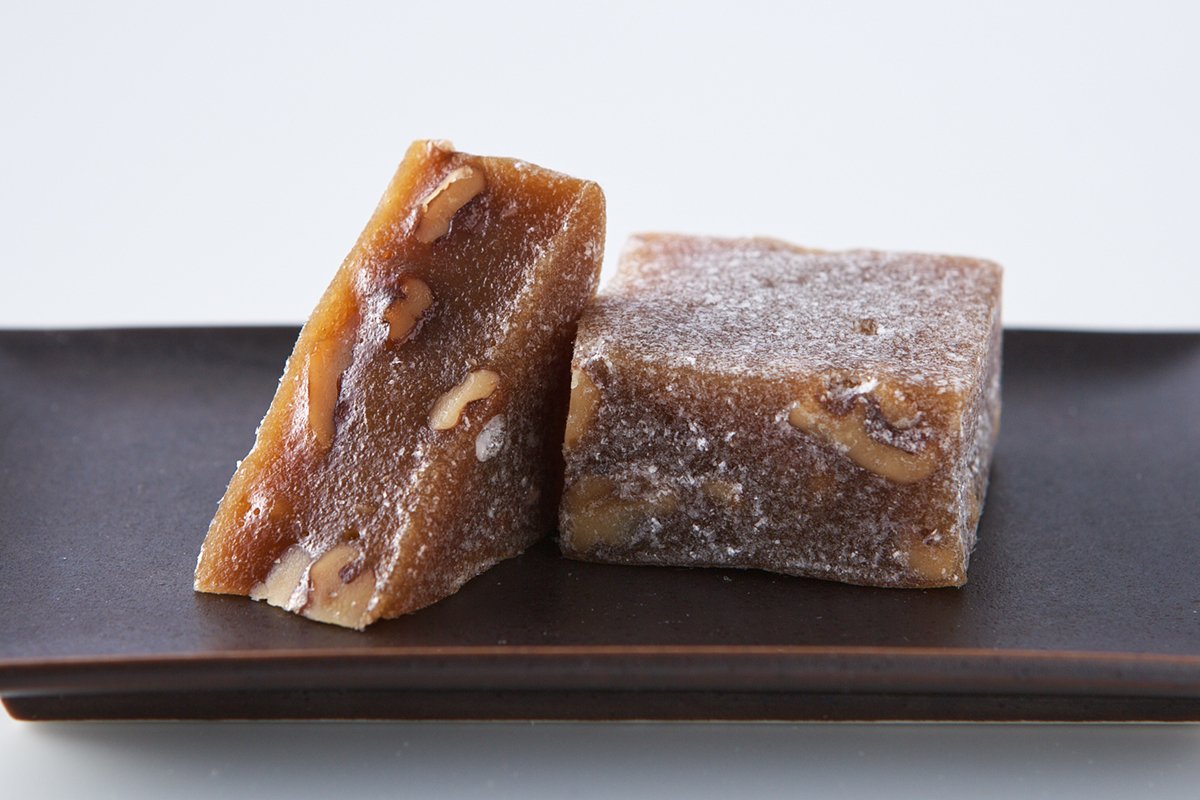
Dig Japan vol.26 “Yubeshi (ゆべし)”
Yubeshi is one of the traditional foods of Japan, and is roughly divided into yuzu fruit and walnut varieties. It is made by mixing yuzu or walnut with rice flour and sugar, kneading, steaming, or boiling it down. Its origins can be seen in the preserved foods of the Genpei period. Yubeshi has various shapes, flavors, and recipes throughout Japan so that there is a type which classified as an accompaniment to alcohol or as a side dish besides wagashi.

Yubeshi can be broadly divided into yuzu fruit and walnut varieties, and the recipe, appearance, and taste vary depending on the region. Yubeshi made with walnut is mainstream in Tohoku and Kanto regions. “Kurumi yubeshi,” made by kneading walnuts into a unique mochi, is a specialty of the Tohoku region, including Fukushima and Yamagata.
Yubeshi made with yuzu fruit is mostly found in western Japan. In the Hitoyoshi and Kuma regions of Kumamoto Prefecture, ingredients such as miso paste, peanuts, sesame seeds, ginger, and chili peppers are stuffed into a hollowed-out yuzu fruit, steamed, and dried in the sun for two weeks to make yubeshi. In Kikuchi City, Kumamoto Prefecture, yubeshi is made by mixing rice flour, grated yuzu peel, miso paste, and sugar, wrapping it in bamboo bark, and steaming it.

The origin of yubeshi is in the preserved food of the Genpei period. During the war-torn era when the two great powers, the Heike and the Genji, were fighting for supremacy, not only weapons but also food was important, and samurai in particular needed portable food that could be eaten quickly and easily. This is where yubeshi came in.
At the time, yuzu, the ingredient for yubeshi, was harvested in abundance, and in order not to waste it, it was steamed, dried, pickled, and processed into preserved foods. It is thought that this matched the demand for battle food for samurai, which led to the development and spread of yubeshi.
Yubeshi seems to have been popular since then, and there is a legend that the Kikuchi clan, a powerful clan from Higo (present-day Kikuchi City, Kumamoto Prefecture), who participated in the Genpei War, noticed the long shelf life of yubeshi and used it for military.
Yubeshi was also used as a portable food during the Sengoku period, and is said to have been used as military rations by the Totsukawa goshi who were guarding the Emperor at the end of the Edo period. During the Edo period, it was also used as a gift, such as offerings to the Tokugawa family.
Meanwhile, after the Edo period, influenced by the developing tea ceremony and food culture, yubeshi gradually changed from a portable food to a Japanese confectionery, and the ingredients and production methods became more diverse, such as steamed sweets and mochi sweets, and it left the battlefield and took root in wagashi culture.
This article was written by 𝐡𝐢𝐫𝐨𝐤𝐨, working as a freelance translator and press for overseas apparel brands in Japan, with the purpose of broadening her insight into the Japanese traditional culture.
いつも読んでくださってありがとうございます☺︎いただいたサポートは、記事のクオリティ向上に活用させていただきます。応援よろしくお願いします❦
